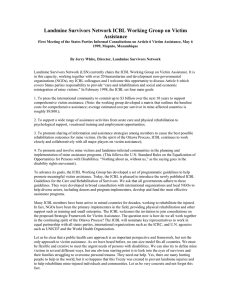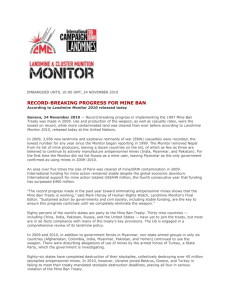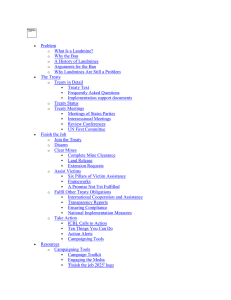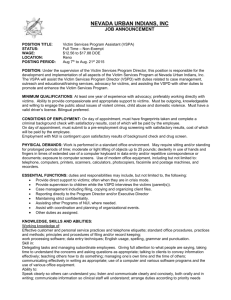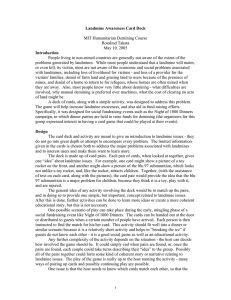The Integration of Victim Assistance Activities
advertisement
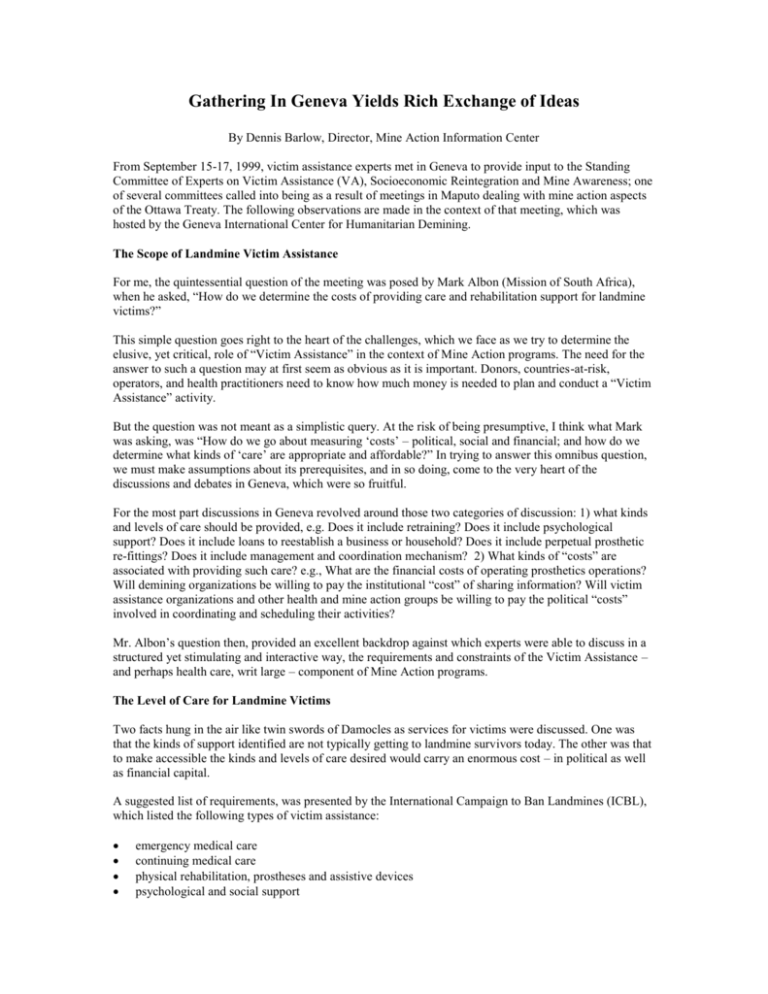
Gathering In Geneva Yields Rich Exchange of Ideas By Dennis Barlow, Director, Mine Action Information Center From September 15-17, 1999, victim assistance experts met in Geneva to provide input to the Standing Committee of Experts on Victim Assistance (VA), Socioeconomic Reintegration and Mine Awareness; one of several committees called into being as a result of meetings in Maputo dealing with mine action aspects of the Ottawa Treaty. The following observations are made in the context of that meeting, which was hosted by the Geneva International Center for Humanitarian Demining. The Scope of Landmine Victim Assistance For me, the quintessential question of the meeting was posed by Mark Albon (Mission of South Africa), when he asked, “How do we determine the costs of providing care and rehabilitation support for landmine victims?” This simple question goes right to the heart of the challenges, which we face as we try to determine the elusive, yet critical, role of “Victim Assistance” in the context of Mine Action programs. The need for the answer to such a question may at first seem as obvious as it is important. Donors, countries-at-risk, operators, and health practitioners need to know how much money is needed to plan and conduct a “Victim Assistance” activity. But the question was not meant as a simplistic query. At the risk of being presumptive, I think what Mark was asking, was “How do we go about measuring ‘costs’ – political, social and financial; and how do we determine what kinds of ‘care’ are appropriate and affordable?” In trying to answer this omnibus question, we must make assumptions about its prerequisites, and in so doing, come to the very heart of the discussions and debates in Geneva, which were so fruitful. For the most part discussions in Geneva revolved around those two categories of discussion: 1) what kinds and levels of care should be provided, e.g. Does it include retraining? Does it include psychological support? Does it include loans to reestablish a business or household? Does it include perpetual prosthetic re-fittings? Does it include management and coordination mechanism? 2) What kinds of “costs” are associated with providing such care? e.g., What are the financial costs of operating prosthetics operations? Will demining organizations be willing to pay the institutional “cost” of sharing information? Will victim assistance organizations and other health and mine action groups be willing to pay the political “costs” involved in coordinating and scheduling their activities? Mr. Albon’s question then, provided an excellent backdrop against which experts were able to discuss in a structured yet stimulating and interactive way, the requirements and constraints of the Victim Assistance – and perhaps health care, writ large – component of Mine Action programs. The Level of Care for Landmine Victims Two facts hung in the air like twin swords of Damocles as services for victims were discussed. One was that the kinds of support identified are not typically getting to landmine survivors today. The other was that to make accessible the kinds and levels of care desired would carry an enormous cost – in political as well as financial capital. A suggested list of requirements, was presented by the International Campaign to Ban Landmines (ICBL), which listed the following types of victim assistance: emergency medical care continuing medical care physical rehabilitation, prostheses and assistive devices psychological and social support employment Jerry White, reporting for the ICBL, reported a cost-analysis, done a year ago, which attempted to identify required needs and accompanying costs for a typical landmine victim in a developing country. His list of needs included: first aid, medicine, hospitalization, psychological and social support, therapy, sports involvement, retraining, and small loans. The total amount was calculated at a modest $9,820 per person annually. The estimated cost therefore, of providing that level of care to 300,000 survivors over ten years was 3 billion dollars. There were several interventions, which suggested additional services, such as: legal aid gender-specific support child-specific support services family support services availability of loans legislative initiatives One central theme was that many of the activities need to be applied in an “integrated” fashion to achieve the most effective and lasting results. Dr. William K. Smith (UNICEF), referred to the “bio-psycho-socio” approach, and Evelyne Viehboeck, of the U.N. Mine Action Service (UNMAS) referred to this method of integrating activities as a good example of systemic thinking. That concept was seconded by White, who noted that little attention is being given currently to the psycho-social needs of landmine victims. Jack Victor, President of the World Rehabilitation Fund, sounded a note of concern over the growing list of perceived needs of landmine victims. While he presented a very progressive list himself, he cautioned that to support landmine victims to such a great extent may have a negative impact on the affected society. Landmine victims, receiving a number of liberal support packages, may receive more aid - and resultant enmity - than other citizens with health problems just as, or perhaps more severe. This thought, while not the most popular of the day, merely reflects reality and will have to be revisited before this entire subject is dealt with and guidelines are promulgated. Victim Assistance, the Mine Action Continuum, and Capacity Building One of the most difficult questions debated – indeed the one which began and ended the VA segment of the conference – was the question of how it, as a discrete set of activities, should relate to the other two major legs of the mine action operational triad: landmine clearance and mine awareness. While clearance and mine awareness activities are specifically germane to mine action programs, many of the actions associated with VA have parallels or direct applications in other health care areas. For instance, prosthetics, trauma treatment, psychological support and other landmine related care activities are also very much applicable to car accident victims, people with certain illnesses and those who are injured by unexploded ordnance. Several interventions made by attending national representatives (the U.S., Cambodia, and Sweden) encouraged a more comprehensive view of the victim’s care needs within the context of an improved health care capacity of the host nation. After much discussion, the group consensus seemed to be that VA as a mine action topic needs to be considered more as a “stand alone” set of capabilities, less coordinated with landmine clearance than Mine Awareness, and more in tune with capacity building within the larger sphere of health care. One of the most thought-provoking interventions in this regard, came from Michael Boddington (POWER) who asserted that governments whose citizens are at-risk to landmines are often incapable of providing the infrastructure to provide the most effective help. He suggested that often the best organization to help build such a capability could be a private organization. Taking note that VA is less concerned with demining as a set of activities than health care as an overarching rubric, several representatives (the ICBL, the Geneva International Center for Humanitarian Demining [GIC], and the International Committee of the Red Cross [ICRC]) at the concluding session suggested that Mine Awareness and VA should be considered under the purview of different standing committees. Ambassador Hofer took note of this suggestion. The Integration of Victim Assistance Activities The greatest sense of “need” was for integration, and of course, nearly everyone was in favor of it. But as the discussions developed I realized that there was confusion owing to the term, “integration.” Some representatives meant it as a way of transitioning a landmine victim back into the mainstream of life. Others were using it to mean the integration of victim assistance activities into an overarching mine action plan, while still others were suggesting that the various organizations involved in the global problem of landmine victims should coordinate their efforts into a more synergistic international effort. I, however, believe that most of the delegates were espousing a desire for a coordinated victim assistance campaign, which would synchronize – and ostensibly manage - the social, medical, legal, legislative, informational, psychological and other components of a national plan. As examples of the kinds of “integration” called for, there were recommendations for: donors to “pool” their funds – or at least to coordinate procedures information and data to be shared bringing bio-psych-socio elements together consolidating (and de-conflicting) donor support mechanisms using the overall development plan as the “roof” for VA activities having UNMAS coordinate the component activities of a VA campaign It soon became apparent that like the numerous kinds and levels of care, there are also numerous types and degrees of integration. This is another concept that will require further discussion and development. Donors Donors were the most frequently discussed group at the meeting; yet there was very little concluded about this all-important group. Indeed, about halfway through the conference, one brave delegate admitted to some confusion over the term and opined that it is a concept “not commonly understood or easily simplified.” Even when the donor is a nation, he observed, it often goes through other organizations and in the last analysis must be looked upon as a sort of alliance. Donors were encouraged to pool funds, coordinate activities with other donors and to make their funding procedures more transparent. They were also asked to budget to allow multiyear funding and for funds not to be earmarked for specific activities. It was also noted that there exists a need to make donors more aware of the nature and challenges of VA activities and programs, so that the foregoing can occur. Information One way in which the VA participants paralleled the views of the other standing committees was in their desire for better and more coordinated information sharing and gathering. The ICBL has listed data collection as one of its needs for VA and even asserted that there is a lack of information about the groups that are involved in performing landmine victims assistance work. UNMAS voiced its desire to have VA data managed and integrated more systemically, and Mr. Chiba of Japan stressed that the sharing of such information must be emphasized. While the call for more and better information sharing was supportive of the ability to plan and implement programs, several organizations stressed its importance in allowing proper monitoring, analysis, and evaluations of on-going and completed activities. It was noted by Mark Albon, for instance that a more “hands-on” and “eyes-on” approach is needed to properly analyze and evaluate programs properly. The need to gather more information was not universal, however. Jerry White struck a common chord with many delegates when he observed that there is sometimes an “…over emphasis on data matrixes and surveys.” He suggested that more operational [informational] support is needed. Sustainment A very useful dialog grew out of a discussion about “ownership” and sustainability. While most delegates felt very strongly about the necessity of the host country and locality owning and directing the program, there were strongly argued counterpoints. It was noted, for instance, that health care skills, perhaps unlike mine clearance or awareness skills, are more complex. Oftentimes a nation-at-risk does not have the capability to manage a complex health care campaign; and it may not be able to sustain one after the practicing NGOs or other firms and organizations move on. An example could be prosthetic services. It may be that a country could served by having an indigenous organization formed to create and fit prostheses, but it may be that such assistive devices made in a more advanced factory outside the host country may offer a superior product. Does one opt for the inferior yet homegrown product, or the more advanced, imported one? The answer involves many other factors. Next Steps for the Standing Committee Ambassador Hofer announced at the conclusion of the gathering that the committee intended to begin preparations for the next set of meetings (March and September, 1999) by addressing initially five major issues (or themes) which arose from discussions and interventions. Both Victim Assistance and Mine Awareness will be discussed by this committee and will address the following topics: Information and Data - Facilitated by the Geneva International Center for Humanitarian Demining (GIC) The Victim Assistance Reporting Structure - Facilitated by Handicap International and the ICBL The Portfolio (overview) of Programs – Facilitated by the ICBL Guidelines – Facilitated by Mexico and Nicaragua Victim Assistance as a Development/Public Health Issue – Facilitated by Sweden and Norway I encourage you, as you or you organization are stimulated or activated by these issues, to monitor or participate in the discussion which these committees and subcommittees will be holding. The rapporteurs for the Standing Committees are staff members of the GIC who can help you learn more about the work of these important committee functions.

